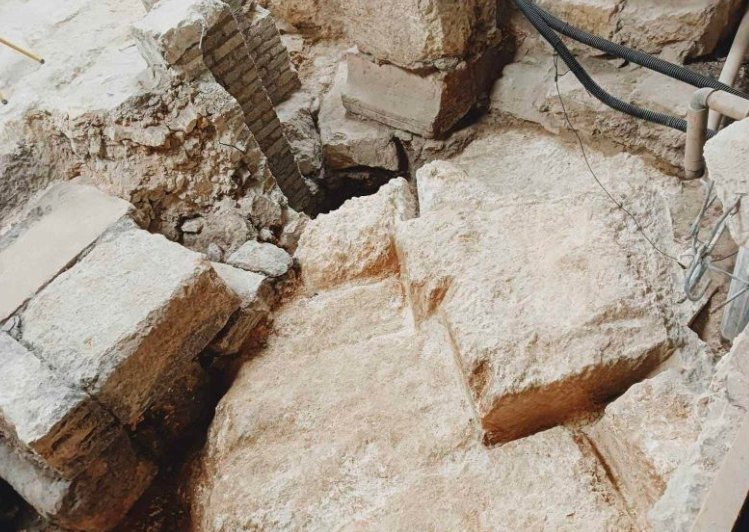Olive and grape remains discovered beneath the Church of the Holy Sepulchre could offer rare botanical evidence tying a biblical garden to Jesus’ final hours.
By all accounts, the Church of the Holy Sepulchre in Jerusalem has always carried the weight of legend. Regarded by millions as the site of Jesus Christ’s crucifixion, burial, and resurrection, its ancient stone floors have long concealed the past. But now, archaeologists believe they’ve uncovered something extraordinary—evidence that could bring one detail of the Gospel of John vividly to life.
For the first time, researchers working beneath the church have found 2,000-year-old plant remains—specifically olive tree wood and grapevine material—that may be remnants of the ancient garden where Jesus was laid to rest after his crucifixion.
A Clue Buried in Scripture
The Gospel of John, 19:41, offers a rare geographical detail of Christ’s burial:
“Now in the place where he was crucified there was a garden, and in the garden a new tomb wherein was never man yet laid.”
That “garden,” until now little more than a theological footnote, may finally have left a physical trace.
Excavations under the Church of the Holy Sepulchre have unearthed botanical evidence dating back to the early first century C.E., around the time of Jesus’ death. The materials—identified as grapevine roots and olive wood—are indigenous to the region and hold religious as well as historical resonance, as both plants feature prominently in Judeo-Christian symbolism.

A High-Stakes Dig Under Sacred Ground
The discovery comes amid one of the most delicate archaeological undertakings in recent memory. Since 2022, an international team of archaeologists, historians, and scientists has been carefully excavating beneath the church with the blessing of multiple Christian denominations and the Israel Antiquities Authority.
Led by Professor Francesca Romana Stasolla of Sapienza University in Rome, the team is using cutting-edge tools such as 3D mapping, ground-penetrating radar, and digital reconstruction to peel back centuries of architecture—layer by layer—without disturbing the fragile integrity of the church itself.
“While we have not been able to see the entire church excavated in one glance,” Stasolla told The Times of Israel, “new technologies are allowing us to reconstruct the bigger picture in our labs. If we were talking about a puzzle, we could say we are only excavating one piece at a time, but eventually, we will have a complete multimedia reconstruction of the full picture.”
What the Archaeologists Found
The latest “puzzle piece” may be the most significant yet.
Alongside artifacts ranging from Crusader-era altars to Roman pottery and oil lamps, researchers recently discovered plant remains embedded in sediment layers directly beneath the church floor. The finds were immediately intriguing—not merely for their age, but for their potential proximity to the very tomb long believed to be that of Jesus.
Initial carbon-dating and paleoenvironmental analysis confirmed the plant material’s age at roughly 2,000 years old, placing them squarely in the Roman period when Jesus is believed to have been crucified under Pontius Pilate.
Equally compelling is the type of vegetation recovered. Grapevines and olive trees were not only common in first-century Judea—they also played key roles in the cultural and spiritual life of the region. Vineyards, in particular, were often cultivated in enclosed gardens, while olive trees represented prosperity, anointing, and peace.
The Tomb and the Garden
The Church of the Holy Sepulchre itself is built over what many Christians believe is the actual tomb of Jesus—a limestone burial cave first identified in the 4th century during the reign of Emperor Constantine. According to historical accounts, Constantine’s mother, Helena, ordered a pagan temple on the site to be demolished after receiving visions about its Christian significance.
Beneath that temple, workers reportedly found a rock-cut tomb. Convinced it was the burial place of Christ, Constantine ordered the construction of the church, which has since been rebuilt and renovated multiple times through the Byzantine, Crusader, and Ottoman eras.
Despite centuries of damage and reconstruction, the central site of the tomb, now enshrined beneath a structure known as the Aedicule, remains intact. The recent discovery of botanical material near this location offers a rare alignment between the biblical account and physical evidence.
A Site of Shared Faith—and Scientific Intrigue
While faith has long held sway over the Church of the Holy Sepulchre, science is now catching up. The discovery does not prove Jesus was buried there, nor that the garden belonged to Joseph of Arimathea, the wealthy man said to have donated his own tomb. But it does demonstrate that a cultivated garden—complete with olive and grape plants—existed at the site during the exact timeframe the Gospels describe.
For archaeologists, that’s not just suggestive—it’s groundbreaking.
And it adds a new layer to one of the most sacred spaces in Christianity. For centuries, pilgrims have flocked to the church to kneel beside its stone slabs, touch the base of the cross, or enter the tomb. Now, they may be walking above what was once an ancient garden—a place of grief, silence, and perhaps, as the New Testament claims, resurrection.













